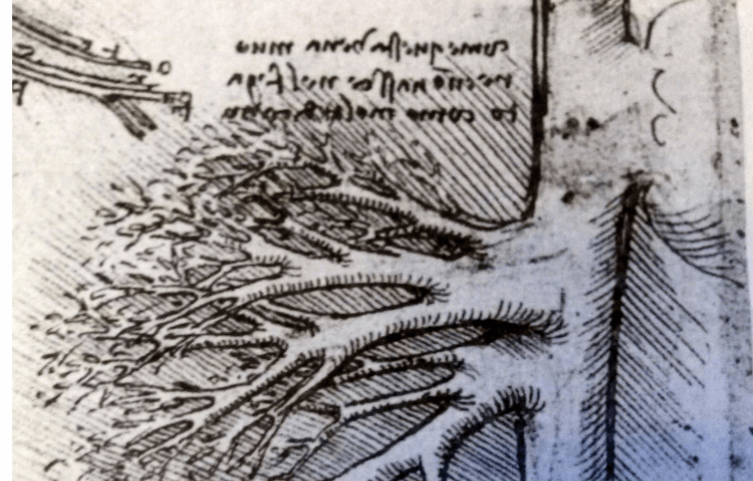In the year 1300, Pope Boniface VIII issued a papal decree, De Sepulturis, which outlawed various methods of lightening the bodies of the diseased for the ease of transport. These methods–common among the Crusaders in the Near East–included the removal of flesh by boiling as well as dismemberment, which also allowed for bodies to be stored in more compact containers. For years after, De Sepulturis was misinterpreted to include the condemnation of anatomical dissection, and for years the study of anatomy would suffer from this misconception. Over time, however, anatomical dissections regained popularity and became important not only to scientists of the body, but also to artists like Michelangelo and Leonardo Da Vinci. However, even into the 1500’s, anatomical sketches were considered distractions unworthy of publication in anatomy textbooks.1

Leonardo Da Vinci, the famous Italian polymath most commonly known today for his painting Mona Lisa, was not renowned for his anatomical diagrams in his time; but unlike his artist peers, his illustrations of the human structure went far beyond the superficial arteries and musculature. While his diagrams do not indicate formal training or even first-hand experience at dissection, Da Vinci began sketching the human anatomy at four different perspectives, simulating a three-dimensional model. Furthermore, Da Vinci sketched the bodily organs, and even wrote about their anatomical functions. It seems that it was Da Vinci’s unquenchable thirst for knowledge and inquiry that drove him to observe deeper than what most deemed necessary. This was characteristic of Leonardo from a young age. Indeed, in 1478, when Leonardo began his career in Florence under the Compagnia de San Luca, he was just sixteen. His early loves for mathematics and mechanics were maintained throughout his life and consistently influenced his vision of the world.4;

Vision was a key aspect to human knowledge to Da Vinci. Being a man of many talents and interests, Da Vinci was drawn to many occupations, and in 1478, after recommending himself to the Duke of Milan, he was made a royal appointee to the duke, Lodovico Sforza, as chief military engineer. In his letter of self-recommendation, Da Vinci referred to himself not only as an artist, but also as a mathematician, architect, and engineer. One of Da Vinci’s first tasks in Milan was to supervise the construction of the Cathedral at Pavia, which would become one of the largest cathedrals in the world. However, it is reported that Da Vinci became so immersed in the theoretical aspects of the physical laws and mechanics involved in the construction of the cathedral that his subordinate had to assume leadership on the practical matters of construction. During this time, Da Vinci also began a practice that has allowed historians and enthusiasts to obtain much deeper insight into the course of Da Vinci’s intellectual studies; like many intellectuals of the Renaissance, Da Vinci began cataloging and recording his studies in notebooks. Many of the anatomical sketches that still survive today were contained in such notebooks. Regardless of his official position as chief military engineer, however, Da Vinci’s primary modes of creation were artistic. Indeed, it was in Milan that Da Vinci finished the paintings Madonna of the Rocks, and The Last Supper; both are masterpieces of human expression and artistic style and technique.5
In 1500, Da Vinci left Milan and continued to paint. He spent several years as a vagabond and finished few paintings during these years, although the famous Mona Lisa was among those left unfinished around the year 1503. At the age of sixty-three, he was appointed to the company of the king of France, near Ambroise, where his chief duty was to keep good company to the king. Leonardo spent the last ten years of his life continuing his research in the realm of the physical sciences, and died on May 2, 1519.6
- Leonardo da Vinci, Leonardo Da Vinci on the Human Body: The Anatomical, Physiological, and Embryological Drawings of Leonardo Da Vinci, eds. Charles Donald O’Malley and John Bertrand de Cusance Morant Saunders (New York: H. Schuman, 1952), 13. ↵
- Leonardo da Vinci, Leonardo Da Vinci on the Human Body: The Anatomical, Physiological, and Embryological Drawings of Leonardo Da Vinci, eds. Charles Donald O’Malley and John Bertrand de Cusance Morant Saunders (New York: H. Schuman, 1952), 131. ↵
- Leonardo da Vinci, Leonardo Da Vinci on the Human Body: The Anatomical, Physiological, and Embryological Drawings of Leonardo Da Vinci, eds. Charles Donald O’Malley and John Bertrand de Cusance Morant Saunders (New York: H. Schuman, 1952), 14-16. ↵
- Leonardo da Vinci, Leonardo Da Vinci on the Human Body: The Anatomical, Physiological, and Embryological Drawings of Leonardo Da Vinci, eds. Charles Donald O’Malley and John Bertrand de Cusance Morant Saunders (New York: H. Schuman, 1952), 14-19 ↵
- Leonardo da Vinci, Leonardo Da Vinci on the Human Body: The Anatomical, Physiological, and Embryological Drawings of Leonardo Da Vinci, eds. Charles Donald O’Malley and John Bertrand de Cusance Morant Saunders (New York: H. Schuman, 1952), 18-21; Toby Lester, Da Vinci’s Ghost : Genius, Obsession, and How Leonardo Created the World in His Own Image (New York : Free Press, 2012), 117-121; Salem Press Biographical Encyclopedia, 2016, s.v. “Leonardo Da Vinci,” by James Livingston. ↵
- Salem Press Biographical Encyclopedia, 2016, s.v. “Leonardo Da Vinci,” by James Livingston. ↵



90 comments
Aaron Jaramillo
Very well done article Chris. It educated me on things that I didn’t know about Leonardo Da Vinci. My family and I still have a part of Da Vinci in out household as we have the Last Supper hanging in our kitchen. But it was enjoying to read that he didn’t just limit himself to art. Great article cant wait for more from you.
Ana Gonzalez
This was a well-written and interesting article! I could tell how much research and time went into your topic. I really enjoyed reading about how Da Vinci was not only an artist but he was also interested and pursued engineering and other occupations. I also really enjoyed the beginning of your article when you were talking about how human dissection was forbidden but was later allowed. Great article, thank you!
Aimee Trevino
Very well written article! I really liked how you explained in the order of how things happened, and took the time to explain. It is interesting to read how Leonardo was so interested, and good, at so many things, like math, engineering, architecture, etc. I also find it interesting that he was so interested in human anatomy, even though it was not common at the time. Just goes to show how ahead of him time he was.
Sergio Cervantes
It was nice to read an article written over the life of Da Vinci and his admirable achievements. All of the information discussed proves that he was extremely important to both, the artistic and medical worlds. The fact that he paid attention to the smallest of details and immersed himself in his work describes a man who was brilliant and focused. He understood his purpose in life and knew how to excel at it as we can see from his drawings. It is great to see that he is also remembered for his contributions to the medical field. Overall, a great article!
Bailey Rider
This was such an interesting article! It was cool to learn that Da Vinci thought of himself not only as an artist but an engineer, mathematician and architect. It’s cool that he was so intersted in the human body and that he had such a thirst for knowledge! He is such an influential figure and the world can learn so much from him. Thank you for the great article!
Victoria Sanchez
This article taught me much more about DaVinci than I already knew. When I think of him, the few things that come to mind are the Mona Lisa, the Last Supper, and his fame as an artist. I was surprised to learn that he held positions such as chief military engineer or was selected to be company to the king of France. I also was surprised to hear of his endeavors outside of the artistic realm that included engineering, anatomy, and mechanics. In my experience these aspects of DaVinci’s talents are not highlighted, but you did a great job of doing just that. I also like how you explained what typical artists and anatomists of the time did in regards to learning and their careers. Overall great information & great article!
Alyssa Vela
This was a great article! As I was reading, I could tell how much research was put into it. I’ve always found myself making Da Vinci references but never fully having any background or even general knowledge on him. The details he put into organs was really interesting, once I read about that my interest had been captured and I couldn’t look away from the screen! This was very informative! I look forward to reading your work in the future!
Gabriela Serrato
I really appreciate that you wrote this article because especially after reading your article, it is obvious that Leonardo Da Vinci was and still is one of the greatest minds in history. He is so admirable for so many reasons. Not only was he intellectually brilliant, but he was also creative and artistic. When I personally saw the Mona Lisa, I was struck in awe by the worldwide fame of it. But now I have an even more appreciation of this piece of art because I know more of the man behind the paintbrush.
Mariana Govea
Wow! What an interesting article! I always thought of Da Vinci as only a famous painter but no it turns out he was a very well rounded man! You did a great job getting your reader hooked at the beginning of your article that I had to keep reading! Its so interesting how you wrote about the various methods that they used to practice to lighten a body in order to be transported, I never knew anything about that how crazy!And its even more fascinating how Da Vinci used to draw this out and go exactly into detail for every organ, which after reading your article it makes a lot more sense now why he chose to do the type of drawings he did because it was during that era that people started to experiment with the bodies to make these methods possible and more efficient! Great informative article!
Alejandro Garza
I had never though of da Vinci as being more than an artist before reading this atricle. It really paints him in a different light to see the contributions he made to anatomical study as mathematics and architecture. Leonardo da Vinci exemplifed the virtues promoted by the Italian Renaissance in a way no one else has with his unquenchable thrist for more knowledge and the means he used to attain it.